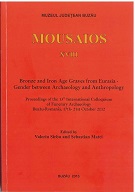Animals and the making of gender in the later period of the Monteoru culture (Subcarpathien Arc between CA. 1700 and 1500 CAL BC)
Animals and the making of gender in the later period of the Monteoru culture (Subcarpathien Arc between CA. 1700 and 1500 CAL BC)
Author(s): Nona PalincașSubject(s): Archaeology
Published by: Muzeul Judetean Buzău
Keywords: Late Bronze Age; social construction of gender; Entrepreneur community; funerary ritual; pottery; cosmology; sun cult; fertility cult; cattle; pigs; shell
Summary/Abstract: In an earlier paper I analyzed the late Monteoru cemeteries (Late Bronze Age in the Subcarpathian Arc − approx. 17th and the 16th c. BC) in terms of body related symbolism and concluded that during the Monteoru IIa phase (broadly the 17th c. BC) the traditional kin centered ties were pushed into the background in favor of ties centered on the smaller family and that at the same time gender relationships were renegotiated with the result that in the following Monteoru IIb phase (broadly the 16th c. BC) the female gender was ranked higher than the male gender. The present paper continues this earlier inquiry into the evolution of gender definitions and relationships by focusing on the symbolic uses of animals. It argues that: negotiations in terms of animal related symbolism were carried out if not exclusively than at least primarily among the rich part of the population; that children rather than adults were used as a means of negotiation; that the social elite resituated femininity and masculinity in relation to the traditional understandings of animals; that most probably at stake was the positioning of genders in terms of fertility conceived as bearing and rearing children; that this preoccupation with fertility is consistent with a low interest in war, the higher ranking of women than men, and the interests of the elites in extending exchange networks within a transegalitarian society of the entrepreneur community type.
Journal: Mousaios
- Issue Year: 2013
- Issue No: 18
- Page Range: 43-78
- Page Count: 36
- Language: English

